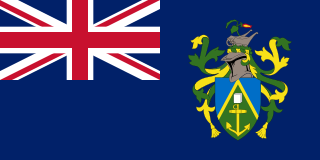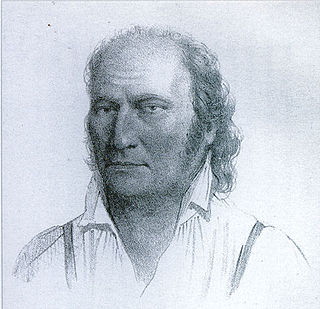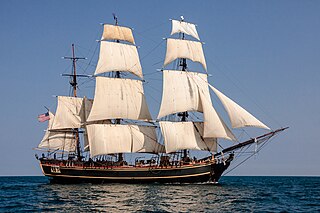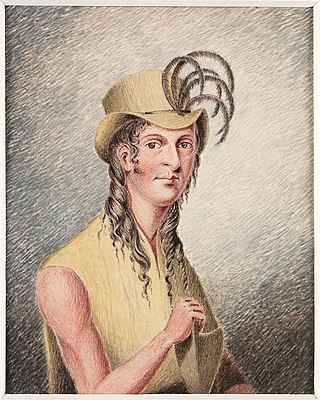Related Research Articles

The Pitcairn Islands, officially the Pitcairn, Henderson, Ducie and Oeno Islands, are a group of four volcanic islands in the southern Pacific Ocean that form the sole British Overseas Territory in the Pacific Ocean. The four islands—Pitcairn, Henderson, Ducie and Oeno—are scattered across several hundred miles of ocean and have a combined land area of about 18 square miles (47 km2). Henderson Island accounts for 86% of the land area, but only Pitcairn Island is inhabited. The islands nearest to the Pitcairn Islands are Mangareva, 688 km to the west, and Easter Island, 1,929 km to the east.

John Adams, known as Jack Adams, was the last survivor of the Bounty mutineers who settled on Pitcairn Island in January 1790, the year after the mutiny. His real name was John Adams, but he used the name Alexander Smith until he was discovered in 1808 by Captain Mayhew Folger of the American whaling ship Topaz. His children used the surname "Adams".

The history of the Pitcairn Islands begins with the colonization of the islands by Polynesians in the 11th century. Polynesian people established a culture that flourished for four centuries and then vanished. They lived on Pitcairn and Henderson Islands, and on Mangareva Island 540 kilometres (340 mi) to the northwest, for about 400 years.

Fletcher Christian was an English sailor who led the mutiny on the Bounty in 1789, during which he seized command of the Royal Navy vessel HMS Bounty from Lieutenant William Bligh.
In 2004, seven men living on Pitcairn Island faced 55 charges relating to sexual offences against children and young adults. The accused represented a third of the island's male population and included Steve Christian, the mayor. On 24 October, all but one of the defendants were found guilty on at least some of the charges. Another six men living abroad, including Shawn Christian, who later served as mayor of Pitcairn, were tried on 41 charges in a separate trial in Auckland, New Zealand, in 2005.
Meralda Elva Junior Warren is an artist and poet of the Pitcairn Islands, a remote British Overseas Territory in the South Pacific. She works in both English and Pitkern, the island's distinctive creole language. Her book, Mi Bas Side Orn Pitcairn, written with the island's six children, is the first to be written and published in both English and Pitkern. As an artist, she works with tapa cloth, a Polynesian tradition. She has also published a cookbook featuring Pitcairn Island cuisine.

The descendants of the Bounty mutineers include the modern-day Pitcairn Islanders as well as a little less than half of the population of Norfolk Island. Their common ancestors were the nine surviving mutineers from the mutiny on HMS Bounty which occurred in the south Pacific Ocean in 1789. Their descendants also live in New Zealand, Australia, and the United States.
Pitcairn Islanders, also referred to as Pitkerners and Pitcairnese, are the native inhabitants of the Pitcairn Islands, a British Overseas Territory including people whose families were previously inhabitants and maintaining cultural connections. Most Pitcairn Islanders are descendants of the Bounty mutineers.

HMS Bounty, also known as HM Armed Vessel Bounty, was a British merchant ship that the Royal Navy purchased in 1787 for a botanical mission. The ship was sent to the South Pacific Ocean under the command of William Bligh to acquire breadfruit plants and transport them to the British West Indies to provide a cheap food source for the West Indies' large enslaved population. That mission was never completed owing to a 1789 mutiny led by acting lieutenant Fletcher Christian, an incident now popularly known as the Mutiny on the Bounty. The mutineers later burned Bounty while she was moored at Pitcairn Island in the Southern Pacific Ocean in 1790. An American adventurer helped land several remains of Bounty in 1957.

Thursday October Christian was the first son of Fletcher Christian and his Tahitian wife Mauatua. He was the first child born on the Pitcairn Islands after the mutineers took refuge on the island. Born on a Thursday in October, he was given his unusual name because Fletcher Christian wanted his son to have "no name that will remind me of England."

Kingston and Arthurs Vale Historic Area (KAVHA) is an old settlement on the Kingston coastal plains, southern side of Norfolk Island, consisting of a large group of buildings from the British Empire's convict era (1788–1855), now considered to be of such cultural significance to Australia and to the World that the area has been formally inscribed onto both the Australian National Heritage List and UNESCO's World Heritage list as amongst:
" .. the best surviving examples of large-scale convict transportation and the colonial expansion of European powers through the presence and labour of convicts."

Pitcairn was a schooner built in 1890 for the Seventh-day Adventist Church for use in missionary work in the South Pacific. After six missionary voyages, the schooner was sold in 1900 for commercial use, and renamed Florence S. She was lost by stranding on the island of Mindoro, Philippine Islands, on 17 October 1912.

The complement of HMS Bounty, the Royal Navy ship on which a historic mutiny occurred in the south Pacific on 28 April 1789, comprised 46 men on its departure from England in December 1787 and 44 at the time of the mutiny, including her commander Lieutenant William Bligh. All but two of those aboard were Royal Navy personnel; the exceptions were two civilian botanists engaged to supervise the breadfruit plants Bounty was tasked to take from Tahiti to the West Indies. Of the 44 aboard at the time of the mutiny, 19 were set adrift in the ship's launch, while 25, a mixture of mutineers and detainees, remained on board under Fletcher Christian. Bligh led his loyalists 3,500 nautical miles to safety in the open boat, and ultimately back to England. The mutineers divided—most settled on Tahiti, where they were captured by HMS Pandora in 1791 and returned to England for trial, while Christian and eight others evaded discovery on Pitcairn Island.

Cricket is recorded as having been played on Norfolk Island, an external territory of Australia, as early as 1838, by soldiers stationed on the island. It continued to be played after the island was settled in 1856 by Pitcairn Islanders, descended from the mutineers of the Bounty and of mixed European and Polynesian stock. John Patteson, an ex-first-class cricketer and future Bishop of Melanesia, was a missionary on Norfolk during that period. From 1876 until well into the 20th century, a match was played annually on Bounty Day, the national holiday, a tradition that was resumed in 1997. In 2001, it was reported that there were three clubs on the island, regular tours from the Australian mainland, and a junior development program, assisted by the New South Wales Cricket Association (NSWCA). Norfolk Island's cricket ground is located at Kingston Oval, which is the oldest cricket pitch in the Southern Hemisphere used since 1838, now with artificial matting overlooked by Kingston's convict-era buildings, which are World Heritage Sites.
Rosalind Amelia Young was an historian from Pitcairn Islands.
Norfolk Islanders, also referred to as just Islanders, are the inhabitants or residents of Norfolk Island, an external territory of Australia. The Islanders have their own unique identity and are predominantly people of Pitcairn and English descent and to a lesser extent of Scottish and Irish.

Norfolk Island is an external territory of Australia in the Pacific Ocean. It was settled in 1788 as with New South Wales and despite its small population and size it has developed its own traditions and legends, some slightly different from the mainland. The island was un-populated when settled, though evidence does suggest that it was home to a population of East Polynesians centuries earlier.
Charlene Evelyn Dolly Warren-Peu is a Pitcairnese politician, who served as Mayor of the Pitcairn Islands from January 2020 to December 2022. She had previously served as Deputy Mayor from 2016 to 2019 and Member of the Island Council from 2014 to 2015.

Mauatua, also Maimiti or Isabella Christian, also known as Mainmast, was a Tahitian tapa maker, who settled on Pitcairn Island with the Bounty mutineers. She married both Fletcher Christian and Ned Young, and had children with both men. Fine white tapa, which was her specialty, is held in the collections of the British Museum and the Pitt Rivers Museum, amongst others.
Teio, also known as Te'o, Mary, and Sore Mummy, was a Tahitian woman who settled on Pitcairn Island with the Bounty mutineers. Alongside Mauatua and Teraura, she is one of the island's six original matriarchs.
References
- ↑ Andrea Vance & Iain McGregor (2019). "Edge of the World: part 2". Stuff. Retrieved 11 February 2021.
The biggest celebration in the island's calendar is Bounty Day, to mark the burning of the ship by the mutineers on January 23. "It's a fish fry at The Landing," Lupton-Christian said. "While we are out fishing the ones who don't go will create a model [of the ship] to burn. We finish off the night with fireworks."
- ↑ Norfolk Islanders Archived May 4, 2007, at the Wayback Machine
- ↑ Norfolk Island Time Line Archived May 3, 2007, at the Wayback Machine
- ↑ Paul Rush (29 August 2013). "Norfolk Island: Sanctuary of timeless loyalty". New Zealand Herald. Retrieved 11 February 2021.